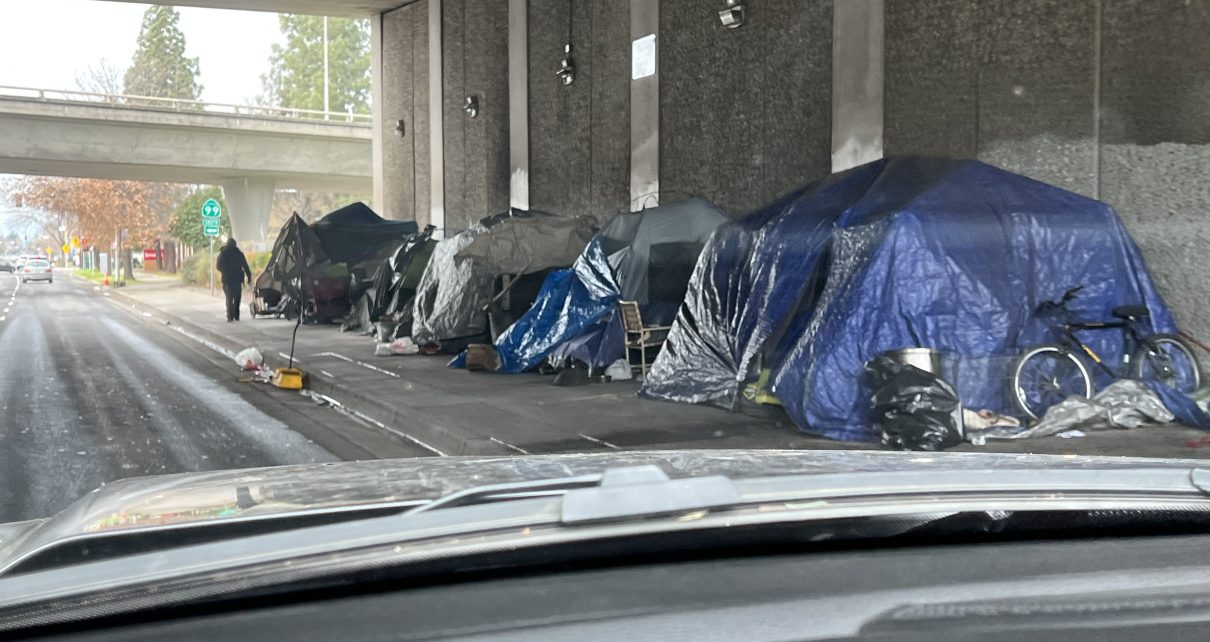
Wall-to-wall homeless transient tents, Sacramento. (Photo: Katy Grimes for California Globe)
SPECIAL: We Can End California’s Homeless Crisis in One Year – These Blue States Show Us How
DAs and Sacto sheriff expose causes of homelessness, and explain solutions
By California Globe, May 31, 2023 9:45 am
Special uncut op ed by: Jeff Reisig, DA Yolo County; Jim Cooper, Sheriff, Sacramento County; Anne Marie Schubert, Retired DA, Sacramento County; Greg Totten, CEO California District Attorneys Association and Retired DA, Ventura County
It is time for new thinking on our homeless epidemic. Every Californian has long witnessed the humanitarian crisis of our present course. But in recent weeks, the situation has hit a tipping point. San Francisco’s exodus of Nordstrom, Whole Foods, and other retailers may not be the most critical data points on this issue. But these events have struck a nerve because they drive home the fact that no one, regardless of their socioeconomic status, is immune from the quality of life deterioration that our communities are experiencing. Our once great cities are being hollowed out. We can no longer keep listening to the same, tired blame game of politics, or keep trying the same approaches that have proven to be abject failures at addressing the crisis.
But we don’t need to look far for the solution. One of the beauties of our democracy is that the respective states are laboratories for policy innovation. California has the highest per capita homelessness of any state in the country. We can do better. Our fellow states have. And it is time to look to those states for the lessons on how.
So here’s what these states offer to teach us—if we’re willing to listen.
First, some would have us believe that our high cost of housing is the problem. But several states with high housing costs have low homelessness. And we’ve spent billions on housing while the problem has grown exponentially. Others argue that our temperate climate is the cause of homelessness. But several states with cold climates also have high homelessness, and others with warm climates have low homelessness. These arguments may be superficially appealing. But facts, as they say, are stubborn things.
However, what does stand out in the facts is that several large, Democratic states have low homelessness. It is these blue states that show us the way to ending our crisis. Let’s take New Jersey, Maryland, Michigan, and Illinois as examples. No one could honestly question the progressive bona fides of Newark, Baltimore, Detroit, and Chicago. Yet the states that are home to each of these cities have substantially lower homelessness per capita than California.
Why?
There is one simple answer–each of these states have much stronger hard drug laws than California. Fentanyl, heroin, other hard drug addictions, and the associated mental health crises that these drugs entail are the root cause of California’s homeless crisis. Until we address addiction and mental health, homelessness in our state will only continue to grow. The stubborn fact is that California’s hard drug laws are out of step with progressive states that have low homelessness.
- In California, there is essentially no consequence for hard drug possession. Therefore law enforcement rarely arrests for the crime.
- In New Jersey, hard drug possession can lead to a 3-5 year sentence and substantial fines. The result is a homeless rate more than 4 times lower than California’s.
- In Maryland, multiple cases of hard drug possession can result in an 18-24 month sentence and substantial fines. Maryland has a more than 5 times lower homeless rate than California.
- In Michigan, hard drug possession can result in a 4 year sentence and substantial fines. Michigan’s homeless rate is also more than 5 times lower than California’s.
- In Illinois, possession of fentanyl can result in a 3-7 year sentence and substantial fines. The result is one of the lowest homeless rates in the country—a rate over 6 times lower than California.
The facts are unmistakable. The way to end our homeless crisis—is to end our drug crisis.
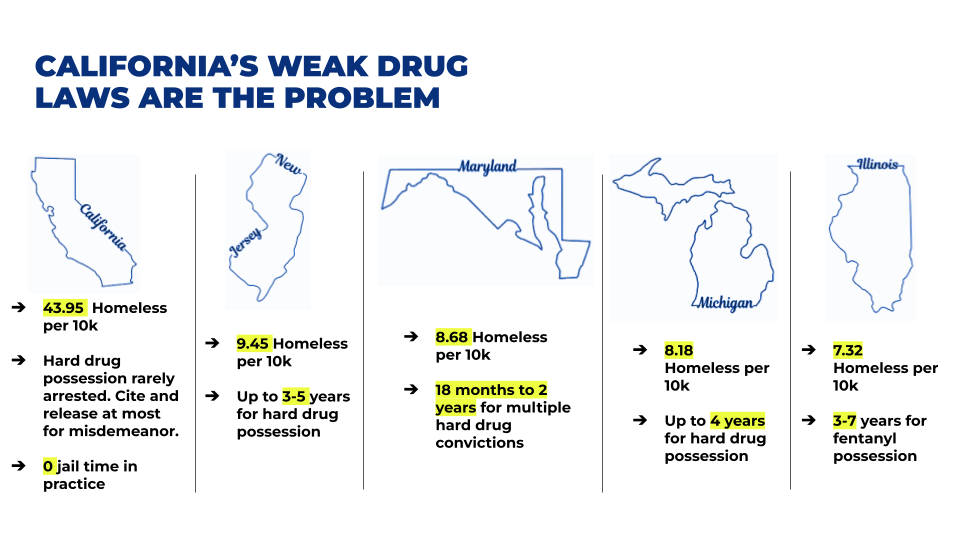
We can end our homeless crisis in one year with a new approach that takes a modest step in the direction of these other progressive states. Here’s how:
First, prosecutors would have the discretion to charge hard drug possession as a new class of crime called a “treatment mandated felony.” The judge would have the final say on whether the defendant should be charged in this manner. The factors that the prosecutor and judge would consider in the decision would include:
- The defendant’s prior history
- The quantity of drugs in the defendant’s possession
- The defendant’s amenability to drug treatment
- Other offenses coupled with the drug possession such as illegal weapons possession
If the defendant is charged with this new, “treatment mandated felony,” an addiction specialist would be assigned to provide a complete suite of services to the defendant including:
- Shelter
- Drug and mental health treatment (outpatient whenever possible)
- Job training
Decades of research have proven that drug treatment in the criminal justice system works. And there are countless shelter beds available from our billions in housing spending. But many of the beds remain empty because we have no system to incentivize people to get the help they need.
If the defendant successfully completes drug and mental treatment, they would receive full expungement of the drug charge. If the defendant refuses drug treatment, they could receive up to 18 months time served. The defendant can short-circuit this sentence at any time by choosing the treatment path instead. If the defendant is re-arrested for hard drug possession, they would be eligible for a complete do-over of the treatment path for as many times as it takes until they get better.
The goal of this proposal is to treat drugs and mental health as the humanitarian crises that they are–to get people the help they need–not to punish them, and to simultaneously reclaim the safety of our communities. But under the current legal framework, there is no accountability in the law when people refuse to get help. New Jersey, Maryland, Michigan, and Illinois understand this. That’s why they created tougher hard drug laws—and it has worked. The result has been exponentially lower homelessness in these states than in California.
This proposal would modestly move California in the direction of these other progressive states that have shown the way on homelessness. With this new approach, drug addiction and mental health would be treated. And we would rapidly get people off the streets, into shelter, and under the care they need.
We can end our homeless crisis in one year. Let’s start today.
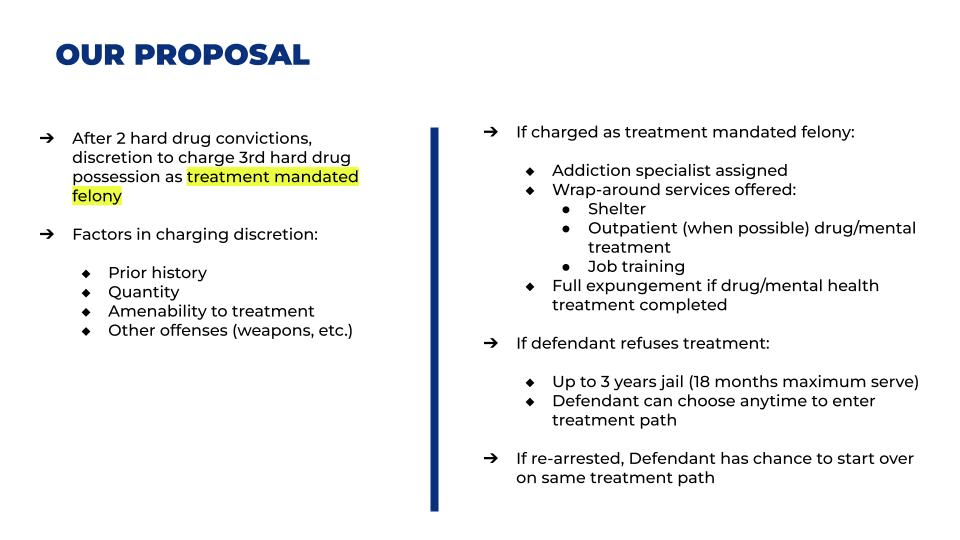

Jeff Reisig is the District Attorney of Yolo County

Jim Cooper is the Sheriff of Sacramento County, and a former State Assemblyman

Anne Marie Schubert is the recently Retired District Attorney of Sacramento County

Greg Totten is the CEO of the California District Attorneys Association (CDAA) and a Retired District Attorney of Ventura County
(An edited version of this piece ran in the Sacramento Bee on May 31, 2023)
- Sen Marie Alvarado-Gil Urges Veto Override by Legislature for Gov. Newsom’s Failure to Protect Firefighters - October 9, 2025
- Pacific Legal Foundation Applauds California’s Move to End Home Equity Theft Loophole - October 4, 2025
- The Longfin Smelt: Another Fish, Another Water Grab - February 10, 2025



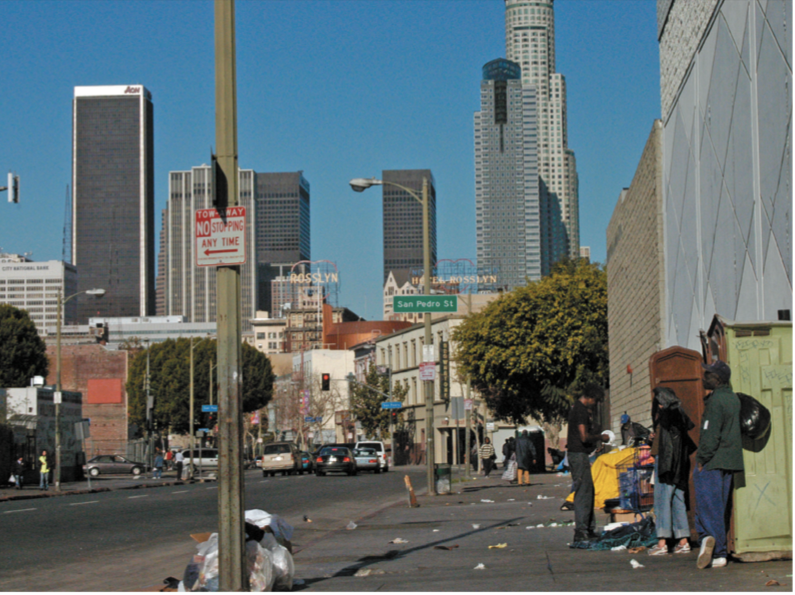
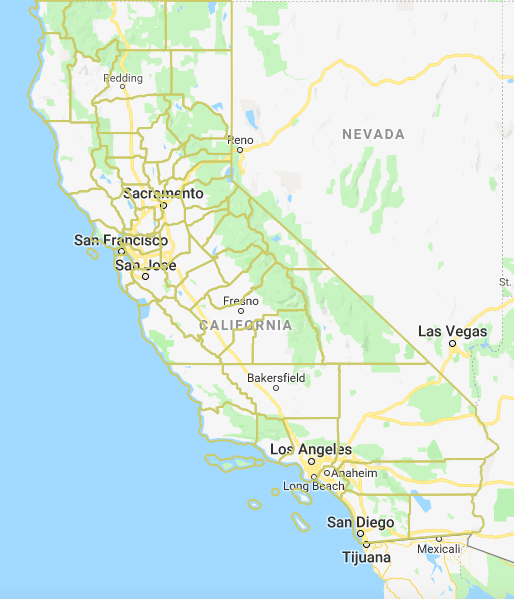
Excellent op ed.
The argument I frequently run into is homelessness is not a crime and to put them in jail is perpetuating a pattern of assault on the “unhoused”.
This piece illustrates how that just is not so.
It is inhumane to let these tortured souls languish on the streets or behind closed doors in a low barrier shelter.
We can do better and should.
First step, vote anyone out who believes that housing first is the solution.
Problem still exists basically shifting homeless to prison systems, because the missing ingredient is showing them how to fish and become independent from govt – this will give them confidence to succeed without this its a vicious circle of dependency.
Democrats want more dependent on GOV – RINOs too. easier to manipulate
The biggest problem with democrat leaders other than the fact that they’re complete psychopaths desperate for power, is that they refuse to admit the main problem is drug addiction! Ironically the democrats are also addicted, addicted to power and will keep blaming evil capitalism for forcing families living paycheck to paycheck out on the street, or lack of housing, expensive housing, equity, Trump, etc! You’ll never solve a problem that you can’t or won’t even properly diagnose! Maybe that’s their goal;)
Most California Democrat politicians benefit from the homeless industrial complex so why would they want to end California’s homeless crisis? Just like the cartels and the mafia, Democrats are a criminal gang?
Addicts aren’t dumb. This proposal doesn’t take into account the weather in the Pacific Coast states, especially California. A survey of homeless would indicate a substantial segment of the population is from out of state encouraged by sanctuary cities that accommodate tent colonies and enable drug use. And why apply for a job or welfare without a legitimate address when shoplifting is so convenient and accessible. Law enforcement is discouraged, crimes are not prosecuted and store owners are liable or fired for protecting or recovering their merchandise. The city of Coronado does not have a problem because they enforce vagrancy laws.
I think the proposal is a good one, but I don’t think it goes far enough. The proposal is a good first start. Unfortunately, the Democrats have dug a hole for us to dig out of with marijuana. As of 2020, one in 20 people age 12 and over has a Cannabis Use Disorder. That includes states where marijuana is not even legal. In California, it is certainly higher than that. We have a serious marijuana problem in this country now. The Democrats, pot lobby, and potheads have lied to everyone about marijuana being benign. A homeless person high on marijuana every day is not employable. Their drug problems need to be addressed, both legal drugs and illegal drugs.
Railing against marijuana belongs in prohibition era thinking. Cannabis Use Disorder 😉
Most of this article is on target, but will probably fall short on the “treatment” option, as it has for many years. Therefore a major effort to detect the key supply chain links and apply major consequences accordingly. I would ask for a 150% effort for 3 months with an option to extend to 6.
If you want to be honest and find an optimum solution you need to look for all possible solutions including “red” state solutions and other parts of the world where low homeless rates exist. What works is what is important. Limiting where you look is a fallacious premise possibly finding only the cleanest shirt in the dirty laundry!
Very well stated!
I think the point of this proposal is to start with evidence based solutions that currently exist in blue states to get buy in from blue staters. I want *all* the options- in custody dependence recovery (and remain in custody until recovery is attained, even if that’s a lifetime sentence), enforcement of vagrancy, border enforcement, possession enforcement, etc – but none of the solutions can be tried without Blue buy in. If the only solutions Blue will support are ones that exist in blue states, we need to start there.
Roseville road is a lightly traveled industrial road in Sacramento county that looked like the worst slum in the world. The county finally cleaned it up, but clean up stopped at the Sacramento City boundary where homeless and their junk is piled high and deep. FYI the City of Sacramento is where the state capitol is.
In Singapore drug trafficking is a capital offence – in other words, punishable by death. Singapore does not have serious drug problems. Singapore is also one of the safest cities in the world. This is not rocket science.
I’ll take “things that will never happen for $1000, Alex….”
Mandatory felony dismissed after treatment is a good start. But unlimited rehab? How about a three strike law or leave the state? And it would go quicker if you closed the border, and prosecuted and deported alien drug dealers.
Know Your History! American lawmakers were / are unprepared for the drug trade. The long road to destroy America included / includes the communist drug trade managed by Cuba, China, Russia. “Red Cocaine” by Joseph Douglass, Jr., PhD. 1990. Published by Soviet analyst Christopher Story. Free download. 195 pages. If you know how to read.
https://americandeception.com/ad/2021/05/19/red-cocaine-joseph-douglass-jr-phd-1990/
Know Your History! American lawmakers were unprepared for the communist controlled drug trade. The long road to destroy America included / includes the drug trade managed by Cuba, China, Russia. “Red Cocaine” by Joseph Douglass, Jr., PhD. 1990. Published by Soviet analyst Christopher Story. Free download. 195 pages. If you know how to read.
https://americandeception.com/ad/2021/05/19/red-cocaine-joseph-douglass-jr-phd-1990/
One problem with this solution is leaving the decisions up to the judge. CA is riddled with far-Left judges who will not change a thing. To the far-Left, imposing anything on anyone is to take away their “rights”. No mention of the rights of the sane people who just want to live their lives.
Sobriety First! This is a good start and should include:
“Greyhound Therapy” is what the homeless call it when other states, both blue and red, round up their own homeless and give them a free, one-way Greyhound bus ticket to CA and only ask one question: SF or LA?
Why are we in CA paying our homeless to stay homeless?
I do not agree – one cannot make a blanket assumption that all who are unhoused use drugs, nor are there empty shelter beds. The majority of those interviewed in San Diego Point- in- time surveys report they became homeless while living in San Diego. High housing costs and low wages are definitely contributing to homelessness and driving countless others out of state.